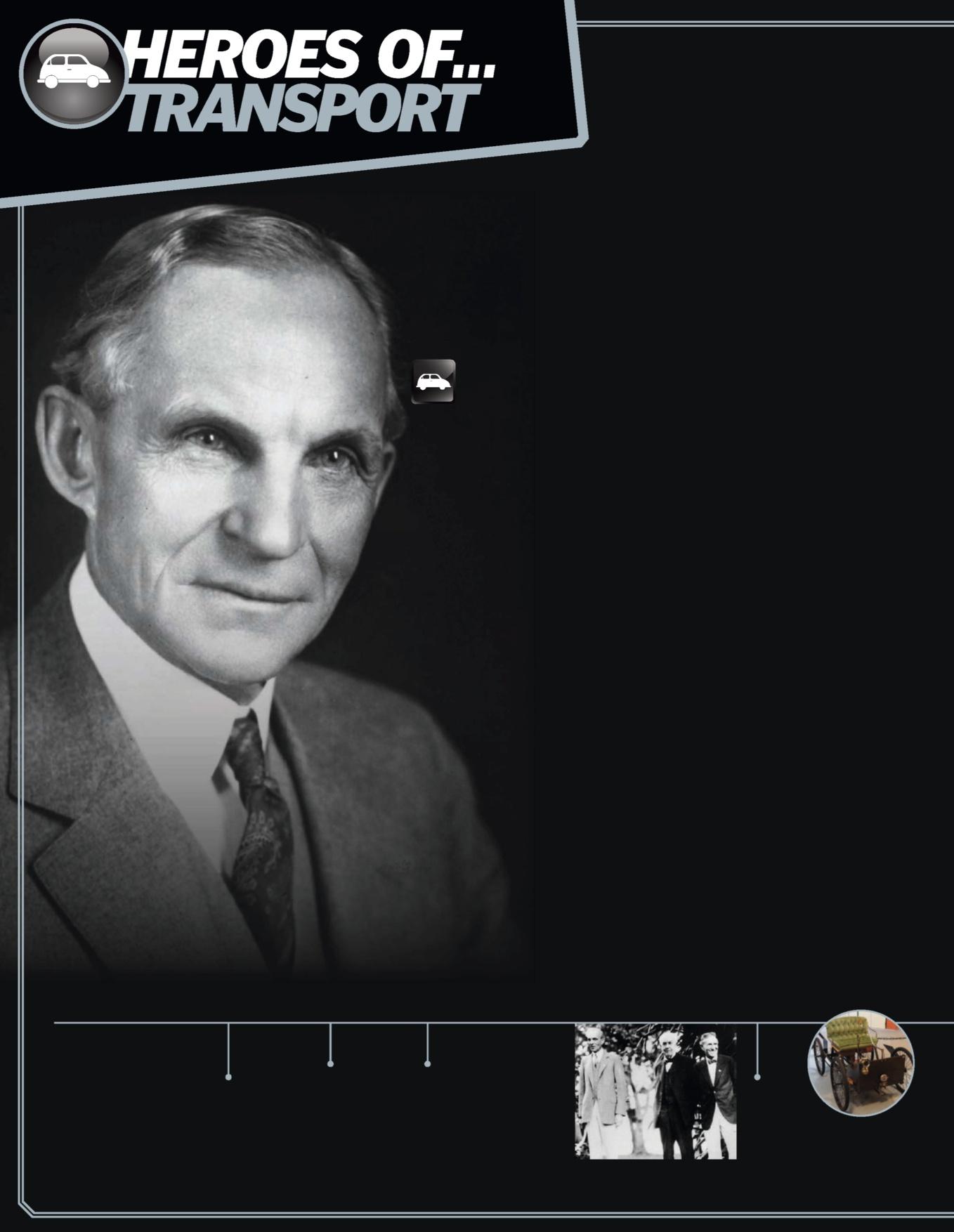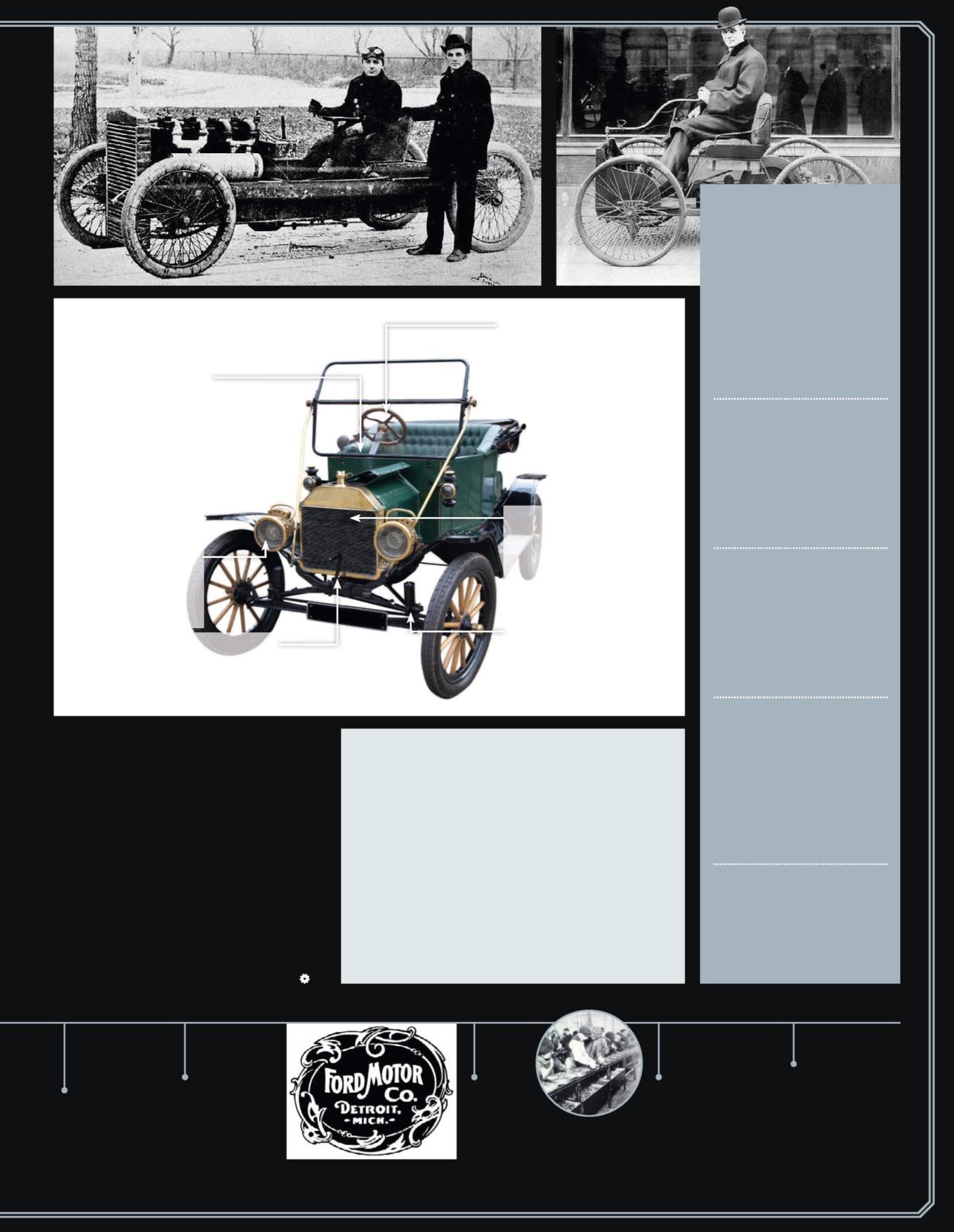
6 minute read
Heroes of… Henry Ford
Henry Ford
How Ford’s model of mass production transported the automobile from exclusive toy of the rich to everyday vehicle for the masses
Advertisement
Henry Ford did not invent the car, nor did he invent the assembly line. What he did do, however, was develop the fi rst large-scale moving assembly line, leading to the mass production and meteoric rise of the everyday automobile. Ford’s beginnings were fairly humble. He was born on a farm in
Michigan in 1863, but as a child he showed little interest in farming, preferring to spend his time dismantling toys and watches to study their inner mechanisms. While still a teenager, Ford left home in 1879 to become an apprentice machinist in Detroit, and in 1891 he took up a job as an engineer at the Edison Illuminating Company. He soon had enough time and money to invest in his own project to develop a horseless carriage. In 1896, he completed his fi rst self-propelled vehicle: the Quadricycle. Gasolinepowered with a simple frame and four bicycle-like wheels, it was steered with a tiller. Its
top speed was a then-impressive 32 kilometres (20 miles) per hour. The Quadricycle’s success led to interest from investors, who helped him establish his own car-manufacturing company in 1899. However, both this and another company of his failed to take off. Determined not to give up though, Ford concentrated his efforts on developing an 80-horsepower racing car, called the ‘999’. This car was raced to victory by Barney Oldfi eld in the Manufacturer’s Challenge Cup in October 1902. Interest in Ford was quickly rekindled, and in 1903 the Ford Motor Company was formed. Ford set to work designing simple, low-cost cars ‘for the great multitude’. In 1908, he introduced the Model T – a simple, affordable motorcar that was easy to operate, maintain and handle on rough roads. The car became so popular at the time that they were selling faster than they could be manufactured, so the company had to devise a new way to meet the growing demand. The solution came in the form of a moving assembly line. Rather than one worker assembling an entire component, they were each allocated one or two parts to put together, which was then passed on to the next person in line until it was completed. This made the process extremely effi cient, and by 1914, the total time for the production of a single Model T had “ Ford set to work designing dropped from 12 hours to just 26 minutes and simple, low-cost cars that 30 seconds. As a result, the cost of the car also fell from $850 to as little as $260. Ford were easy to maintain, operate expanded sales and manufacturing overseas, and handle on rough roads” and by the early-Twenties, half of the cars in the world were Model Ts.
A life’s work
The major milestones in Henry Ford’s journey to international fame
1863
Henry Ford is born on a farm in Michigan to parents William and Mary.
1879
Henry moves to Detroit, Michigan, to begin his apprenticeship as a machinist.
1891
He is hired by Edison Illuminating Company as an engineer, where his passion for automobiles is encouraged by Thomas Edison.
1896
Henry builds his fi rst self-propelled vehicle, the Quadricycle, which reaches a top speed of 32km/h (20mph).
Exploring the Model T
The simple design of Ford’s best-selling car secured its success and revolutionised the auto industry
Transmission (not shown)
The two-speed planetary gearbox had one pedal for the clutch, one for the brake and one for reverse, as well as two hand levers for throttle and neutral/ parking brake functions.
Headlights
These were originally acetylene lamps made of brass, but in 1915 new cars were fi tted with electric lights.

Hand crank
Early models were started using a hand crank, but by 1920 they were equipped with battery-powered starters.
Steering wheel
The Model T’s left-hand drive set the standard for the US and European car industries.
Engine
Model Ts had a four-cylinder engine that produced 20bhp, giving the car a top speed of 72km/h (45mph).
Suspension
The three-point suspension system allowed for plenty of wheel movement, to prevent damage on the very rough early roads.
However, sales of the Model T gradually declined, overtaken instead by General Motors’ more comfortable and more powerful Chevrolet. Other models were developed, but none saw the same level of success as the Model T. In 1932, at age 69, Ford introduced his last great innovation – the lightweight, inexpensive V8 engine. But even this wasn’t enough to reclaim his lead in the US market, so by 1936, Ford Motor Company had been outdistanced by both General Motors and Chrysler Corporation. Still, Ford’s assembly line became the standard model of production of the 20th century, accelerating the growth of a middle class and giving the freedom of mobility to millions.
Moving with the times
The moving assembly line completely changed the face of manufacturing. The minimal and repetitive motions of each worker sped up effi ciency. Minimal training was required, meaning Ford could employ unskilled workers, many of whom were immigrants. However, this also meant that the work was incredibly boring, and the turnover at the company was so high that Ford had to hire 53,000 people a year to keep a constant workforce of 14,000 at the plant. To overcome this, in 1914 Ford more than doubled its wage rate to $5 a day to reduce the high employee turnover – an amount that was unheard of for unskilled work. Now that the factory workers were able to afford the cars they were making, the job became that much more desirable, which led to Ford being able to secure its position as the leading car manufacturer in the world at the time.
Top 5 facts: Henry Ford
1A WWI pacifi st Henry Ford strongly opposed World War I and funded a Peace Ship that set sail to Europe with the aim of kick-starting peace negotiations. This mission was soon aborted though.
2Anti-semitic Despite being one of the country’s largest employers of black and migrant workers, Ford was anti-semitic and published a number of texts in which he blamed Jews for manipulation of the market.
3Ventures in aviation Ford also designed and manufactured aeroplanes, including one which would become the fi rst successful US airliner. The plane’s maiden fl ight took place in 1926 and it carried 12 passengers.
4Monochrome manufacturing
Until the development of the assembly line, Ford cars were only available in one colour, with Ford famously saying: “Any customer can have a car painted any colour that he wants, so long as it’s black”.
5Driving on ice In 1904, Ford broke the land-speed record driving his ‘999’ racing car across a frozen lake. He reached a top speed of 146km/h (91mph).
1902
Ford’s 80bhp ‘999’ racer wins the Manufacturer’s Challenge Cup.
1903
The Ford Motor Company is founded with the help of several investors.
1908
The Model T goes into production and becomes the biggestselling car in the world.
1914
Ford announces that it will more than double its workers’ wages to $5 a day.
1932
At age 69, Ford develops the compact and low-cost V8 engine, which outperforms all other competitors.


